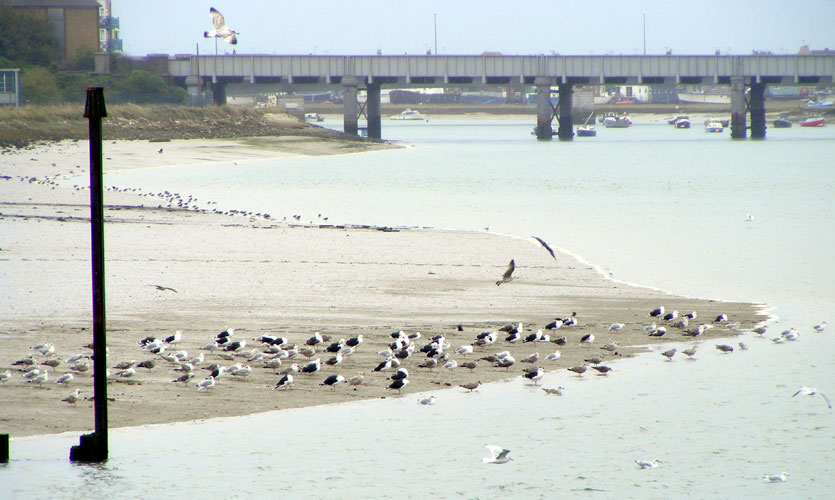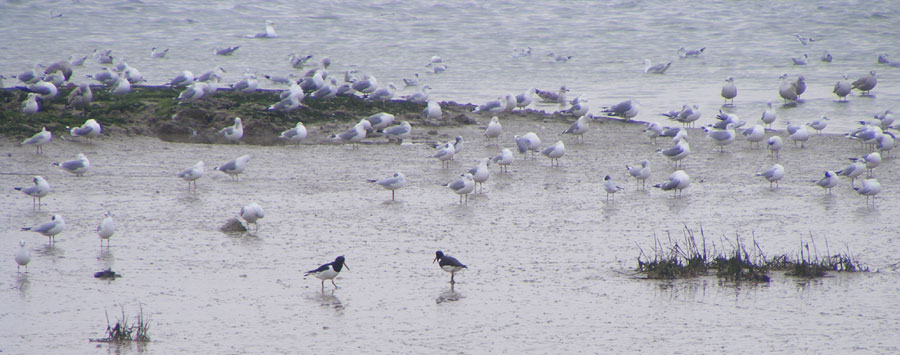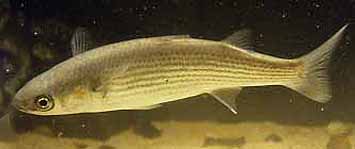 |
| Adur Flood Plain |
| Chalk Downs |
| Coastal Fringe |
| Intertidal (Seashore) |
| River Adur Estuary |
| River Adur |
| Sea (off Sussex) |
| Town & Gardens |
| Widewater Lagoon |
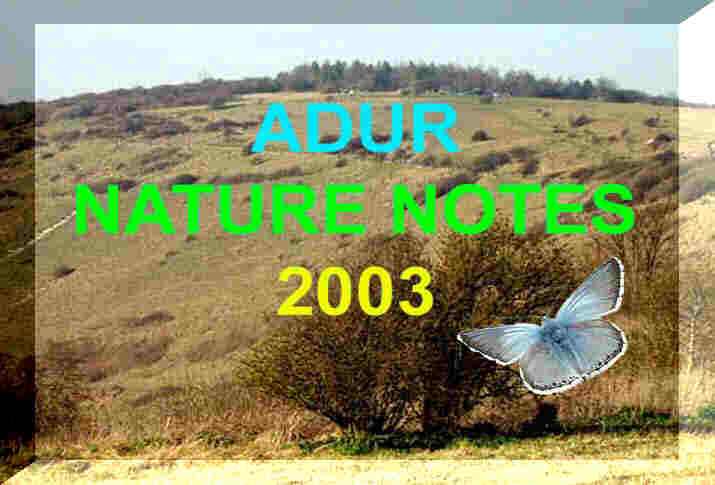
|
|
|
|
(ADUR VALLEY & DOWNS) |
|
|
|
|
|
- The
mud flats are a roosting site for gulls and waders, especially in the colder
months.
The mud flats (TQ 208 056) including the RSPB Reserve has been notified from 1987 as a Site of Special Scientific Interest (SSSI) under Section 28 of the Wildlife & Countryside Act 1981.
1 October 2019New growths of Sea Blite on the widened River Adur by Shoreham Airport
25 October 2018
A flock of a hundred plus Lapwings were back on the mud flats nearest to the Toll Bridge at low tide in the afternoon. They were very skitty, and after five minutes something spooked the whole flock and the big mud flat to the north of the Toll Bridge was bare again. The Lapwings flew around a bit and then decamped to the mud on the inside of the meander bank almost underneath the Flyover.
16 September 2018
Four Grey Herons flying very low over the Downs Link Cyclepath just north of the Flyover (100 metres north of the Wood Heron) were my surprise in the middle of the day.They are very large birds and their sudden appearance all at the same time, and not much above the height of the hedgerows, legs outstretched (landing gear down), came as a bit of a shock. They sent hundred of Common Gulls into flight, under a cloudy sky, before they landed on the mudflats of the River Adur (out of sight).
25 October 2016
Old Shoreham
Estuary with Sea Blite, Sea Aster and Sea PurslaneSalt marsh plants fringe most of the estuary and in places have colonised large areas of mudflats. Sea Purslane Halimione portaculoides dominates most of the areas above mean high tide mark, and Annual Seablite Suaeda maritima is also extremely frequent in these areas. On bare mud Glasswort Salicornia sp. is the first coloniser and nearer low water mark sea aster Aster tripolium becomes more abundant. Other species are scattered throughout the salt marsh community, include Sea Spurrey Spergularia marina, Sea Plantain Plantago maritima and Saltmarsh Grass, Puccinella maritima. Cord Grass Spartina spp. is noticeably absent from most of the estuary, but a small stand grows southeast of the Toll Bridge.
Sea Purslane and Sea Blite
27 September 2016
A Grey Heron fished in the middle of the River Adur on a low neap tide approaching 3:00 pm in the afternoon, after the first rightangle meander of the river north of Old Shoreham. It was not alone; a dog disturbed the hundred or so Common Gulls and couple of Cormorants. A few Little Egrets are so regular to be hardly worth a mention nowadays. Two small chirms of Goldfinches flew around the Hawthorn and other hedgerow shrubs. These chirms comprised only a handful of birds in each (unless that were part of a larger chirm unseen). It was too cool for any butterflies.River Adur Estuary
Sea Spurrey, Sea Blite, Cord Grass, Glasswort
Glasswort, Cord Grass, Sea Purslane, Sea Purslane10 September 2012
Cord Grass

2 December 2011
On the River Adur there was the usual collection of common gulls and waders; most noticeable were the Greater Black-backed Gulls and Lapwings as the tide was low and the mud flats revealed. There were a few Grey Plovers.
The Sea Purslane, Halimione portulacoides, is a small greyish-green shrub abundantly found on the mud flats of the River Adur that are even covered twice daily by the neap tides, but also nearer the high tide margins. It is a halophyte with leaves with a silvery sheen filled with air (not sap) and are dead when the plant reaches maturity. Halimione = Daughter of the Sea (Greek)
5 November 2009
On the return journey (from Lancing Ring) the tide had receded revealing some of the mud flats on which a pair of Redshanks were courting, running around together, flying short distances in unison and swimming together in the shallow river, like ducks.25 October 2009
About fifty Lapwings all rose in unison from the mudflats on the River Adur north of the Toll Bridge, spooked by a female Sparrowhawk seen above the trees near Ricardos. The Sparrowhawk was seen much closer from the Coombes Road over the Ricardos testing ground. A Linnet perched on a fence near Cuckoo's Corner. In the field to the north a few hundred Common Gulls rested on the ploughed Broad Bean field, occasionally rising up in unison for no reason that could be ascertained.11 October 2009
On a cloudy day with spots of rain there were scores of Greater Black-backed Gulls and occasional Grey Plovers on the mudflats at mid neap tide south of the Toll Bridge in Old Shoreham.A Lapwing wheeled around waiting to land when more of the mud was exposed.
1 March 2009
There were two Oystercatchers feeding over the mud flats south of the Toll Bridge with hundreds of gulls.The gulls were mostly a mixture of Common Gulls and Black-headed Gulls, with frequent Herring Gulls and occasional Greater Black-backed Gulls.
21 December 2008
There were thousands of birds on the River Adur at low tide, notably thousands of Lapwings, thousands of medium-sized gulls, mainly Common Gulls, hundreds of Dunlins, Redshanks, occasional Grey Plover, a few Cormorants and Mute Swans, scores of Great Black-backed Gulls and hundreds of Black-headed Gulls all noted in the area between the Railway Viaduct and Cuckoo's Corner. Thousands of Common Gulls settled on the ploughed field north of Cuckoo's Corner.
10 October 2008
At low tide on the mud flats opposite Coronation Green in Shoreham town, a handful of Grey Plovers were feeding on the southern bank in the middle of the River Adur, before a Redshank and a band of about ten Turnstones appeared on the near bank, constantly on the move, literally turning over the small stones in search of morsels. A Cormorant, a Little Egret, a few Dunlins and immature Herring Gulls were noted. A pair of Mute Swans flew overhead calling loudly.
Further up the estuary on the main part of the river in the vicinity of Cuckoo's Corner there were about three hundred gulls, which were mainly Common Gulls, but contained other species including Great Black-backed Gulls. A Cow wandered down to the exposed mud flats and began to drink from the tidal river.
3 December 2007
A Kestrel hovered over the Sea Purslane at low tide south of Old Shoreham Tollbridge and then descended. The target prey was not determined.25 August 2005
After the rain I ventured out as the spring tide nearly lapped against the banks of the Adur estuary. Just south of the Toll Bridge there was still a margin of vegetation above the high tide mark on the east side of the river, with Orache and other wild grasses and plants and this area hosted dozens of active grasshoppers that appeared to jump at least of metre. They looked slightly different from the two commonly found on the downs meadows and wastelands on the edge of town. I think some of them are probably the Lesser Marsh Grasshopper, Chorthippus albomarginatus.
Adur Grasshoppers
Estuarine Flowering Plants
The upper tidal zone of the mud-flats contained Sea Purslane and Glasswort in prevalent amounts and bunches of Townsend's Cord Grass.
20 October 2003
The low tide means that it is just about possible to examine some of the plants on the flats without squelching through the soft mud.
Small patches of what is probably Townsend's Cord Grass, Spartina townsendii, were found south-east of the Toll Bridge. Townsend's Cord Grass has a particularly interesting origin (see the Reader's Digest "Secrets of the Seashore" page 75, a new plant species evolving in the nineteenth century).
|
|
|
|
|
|
|
|
Although not quite so dramatic as Widewater, the Sea Blite on the estuarine margins have now turned a dramatic red.
Glasswort Images19 October 2003
The neap tide variation between 2.36 metres (low at 12.04 pm) and the high tide of 4.4 metres (6:14 pm in darkness) is one of the smallest possible. (The equinoctial spring tide variation could be up to 7 metres).
BMLSS Tides16 September 2003
The green of the Glasswort, Salicornia, on the River Adur was in contrast to the rich red-purple hues of the mostly submerged (this year) Glasswort on Widewater.On close examination, the larger river plants seemed to have a red line up their stems. This was Sea Blite.
Verdant Mud 1999
In
the prolonged hot and dry spell for the complete month of July, the mud
flats on the part of the River Adur that runs through the centre of Shoreham-by-Sea,
West Sussex, turned green with a rapid spread of the salt tolerant green
plant known as the Common Glasswort,
Salicornia europea.
This plant is collected for food when it is known as Marsh Samphire, and
is meant to be a poor man's asparagus. It tastes like a mouthful of seawater
to me. The plant roots in the estuarine mud in salinities
of about 3.2% but variable from full salinity with an incoming spring tide,
to fresh water running out over the top of the sea water.
Nearer the riverbank, Sea Purslane, Halimione portulacoides, predominates. It is easily distinguished from Glasswort because its conventional leaves have a silvery sheen.
Seablite, Suaeda maritima, is extremely frequently to be found, and theSea Aster, Aster tripolium, also commonly occurs.
The
Sea Lavender, Limonium vulgare was introduced, but may no longer
occur. The Cord Grass, Spartina spp. occurs.
In
the river opposite Ropetackle (Between the Norfolk bridge
and the Railway Viaduct), in the pools between the mussel
beds at low tide, small clumps of Irish Moss, Chondrus crispus,
grow on the mussel and oyster shells and small flint rocks. This red seaweed
is usually a dark brown, sometimes with a slightly iridescent hue, and
in very bright sunlight, the weed will turn green at the tips and stranded
specimens are often bright green as shown in the image (above) scanned
in by David Wood (Shoreham Beach).
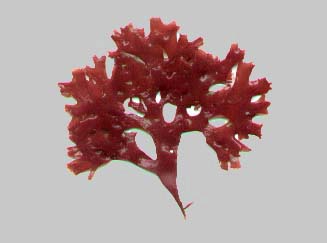
Irish Moss (normal colours)
Mud Dwellers
Ragworm
Hediste
diversicolor
Peppery
Furrow Shell Scrobicularia plana
Algae Homepage (Univ. of Galway)
Algae (Adur Estuary) List
Kingston Beach, by the Lighthouse, is near where the river enters the sea between the two piers of Shoreham Harbour.
- Local
Wildlife Links (SE England)
Adur
Nature Notes 2000
Adur
Nature Notes 2001
Adur
Nature Notes 2002
Adur
Nature Notes 2003
Adur
Nature Notes 2004
Adur
Nature Notes 2005
Adur
Valley
Adur
Valley Wildlife
Bridges
of the Adur
British
Trust for Ornithology
Chalk
Rivers Biodiversity (JNCC)
Cornwall
(Geomorphology, Eclipse etc.)
Dungeness,
Kent, England
Friends
of Lancing Ring
History
of the Adur Estuary by H. C. Brookfield (written 1950-1)
Orford
Ness: Coastal Ecology of a Shingle Bank (excellent references)
Rare
Birds Photographic Index (by month) (All of Britain)
Rye
Harbour Nature Reserve
Rockpooling
Page
Seashore
Page
Shingle
Coast (Coastal Fringe of Shoreham Beach)
Shoreham-by-Sea
Wildlife Page
Sussex
Ornithological Society
Sussex
Wildlife Trust
Sussex
Wildlife Web Sites
Trees
(British) External site
UK-LEPS
Discussion Group (for Butterflies and Moths)
World
Oceans Day
|
|
|
|
|










